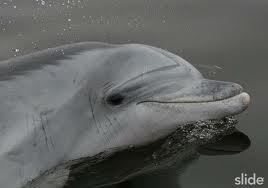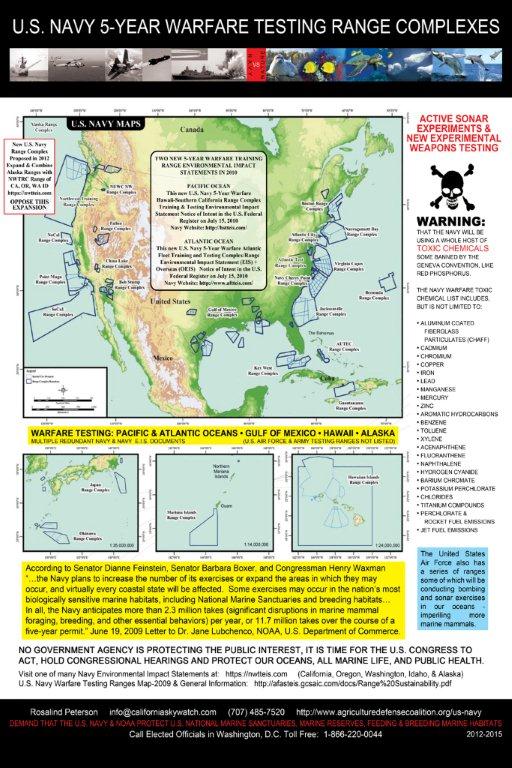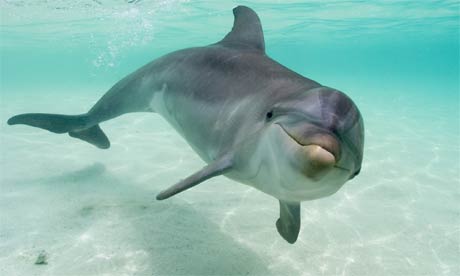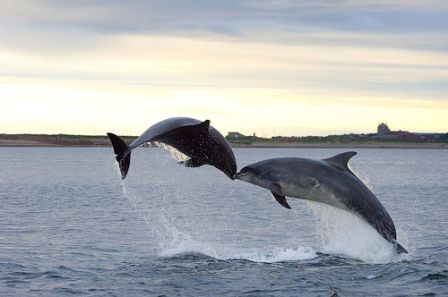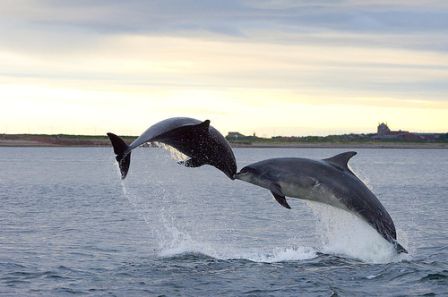U.S. NAVY’S TWELVE 5-YEAR WARFARE TESTING PROGRAMS &
THE INCREASING & ONGOING THREAT TO THE GULF OF MEXICO, ATLANTIC & PACIFIC OCEANS
HELP SAVE OUR MARINE MAMMALS & THEIR OCEAN HABITAT TODAY!
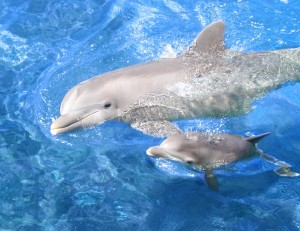
What is a Stranded Marine Mammal?
The following report presents specific information regarding marine mammal stranding events that may
have been associated with U.S. Navy activities. Additionally, this report provides general information on
other threats to marine mammals (natural and human‐made) that may cause or contribute to
strandings.
The majority of animals that strand are found dead or dying. For animals that strand alive, human
intervention through medical aid and/or guidance seaward may be required for the animal to return to
the sea. If unable to return to sea, rehabilitation at an appropriate facility may be determined as the
best opportunity for animal survival.
Strandings are generally categorized as single, mass, and unusual mortality events. The most frequent
type of stranding involves only one animal (or a mother/calf pair). Along the coasts of the continental
United States, Alaska, and the U.S. Pacific Islands (including Hawaii) over a 9‐year period (2001‐2009),
there were a total of 51,649 reported marine mammal strandings (12,545 cetaceans [average 1,394 per
year] and 39,104 pinnipeds [average 4,345 per year])
read the remainder of the file/report here : http://hstteis.com/Portals/0/hstteis/SupportingTechnicalDocs/Marine%20Mammal_Stranding_Report_v02.pdf

CALL TO ACTION* CALL TO ACTION FROM ROSALIND PETERSON* CALL TO ACTION
PLEASE HELP US
We do not elect to be the guinea pigs for these experiments or to have our oceans used for massive warfare testing.
Say “no” today…Ask for U.S. Congressional Hearings to protect human health and our marine mammals.
Call Your Elected Officials in Washington, D.C. Toll Free:(1866) 220-0044)
Rosalind Peterson
Agriculture Defense Coalition
Post Office Box 499
Redwood Valley, CA 95470
(707) 485-7520
Please listen to the interview with Rosalind Peterson and her urgent message to the public. (Interview May 2012)
HAWAIIAN RESIDENTS
“Welcome to the United States (U.S.) Department of the Navy’s Hawaii-Southern California Training and Testing Environmental Impact Statement (EIS)/Overseas Environmental Impact Statement (OEIS) website, an online resource for information concerning the training and testing activities within the in-water areas from Hawaii to the coast of Southern California.
The U.S. Navy invites you to participate in the National Environmental Policy Act (NEPA) process for the Hawaii-Southern California Training and Testing Environmental Impact Statement/Overseas Environmental Impact Statement (EIS/OEIS). The Navy has prepared a Draft EIS/OEIS to ensure the consideration of potential environmental effects from naval at-sea training and testing activities in the Navy’s Hawaii-Southern California Training and Testing Study Area.” http://hstteis.com/Home.aspx Click the GET INVOLVED tab on the site.
“An OEIS is prepared to comply with U.S. Executive Order 12114, Environmental Effects Abroad of Major Federal Actions, of 1979. The Executive Order requires federal agencies to consider the potential effects of their actions on the environment outside U.S. territorial waters. U.S. territorial waters extend 12 nautical miles from shore.”
HOLD THE AGENCIES ACCOUNTABLE!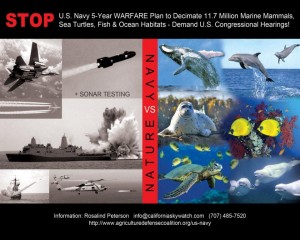
U.S. Navy Atlantic Fleet Public Comment Period is from May 11, 2012
through July 10, 2012
Home Website with Range Map: http://aftteis.com/Home.aspx
http://aftteis.com/GetInvolved/PublicMeetingLocationsandDates.aspx
http://aftteis.com/GetInvolved/HowCanICommentonthisEISOEIS.aspx
http://aftteis.com/GetInvolved/HowCantheCommunityBeInvolved.aspx
This is from the U.S. Navy NWTRC Range on Hazardous Materials-Bombs,
etc. There is one of these sections for each of the 12 Ranges in operations.
From Rosalind Peterson CALL TO ACTION
ALERT – NEW PROTECTION NEEDED FOR OUR MARINE MAMMALS & NATIONAL MARINE SANCTUARIES FROM U.S. Navy 5-YEAR WARFARE TESTING EXPANSION IN THE PACIFIC & ATLANTIC OCEANS – SAVE OUR WHALES
U.S. NAVY’S TWELVE 5-YEAR WARFARE TESTING PROGRAMS &
THE INCREASING & ONGOING THREAT TO THE GULF OF MEXICO, ATLANTIC & PACIFIC OCEANS
HELP SAVE OUR MARINE MAMMALS & THEIR OCEAN HABITAT TODAY!
A CALL TO TAKE ACTION
By Rosalind Peterson
May 11, 2012
The Washington Post (Associated Press) May 11, 2012 – Revealed today that a “New Navy study says use of sonar, explosives may hurt more marine mammals than once thought”[25]. “…HONOLULU-The U.S. Navy may hurt more dolphins and whales by using sonar and explosives in Hawaii and California under a more thorough analysis that reflects new research and covers naval activities in a wider area than previous studies…” (The Public Comment period for the new U.S. Navy Atlantic/Gulf of Mexico 5-Year Warfare Testing Range that will use bomb blasts and Sonar is from May 11, 2012 through July 10, 2012 [8C]).
The Washington Post also stated: “…The Navy estimates its use of explosives and sonar may unintentionally cause more than 1,600 instances of hearing loss or other injury to marine mammals each year, according to a draft environmental impact statement that covers training and testing planned from 2014 to 2019. The Navy calculates the explosives could potentially kill more than 200 marine mammals a year…” (The Public Comment period for the new U.S. Navy Pacific 5-Year Warfare Testing Range that will use bomb blasts and Sonar is from May 11, 2012 through July 10, 2012 [8B]).
What do your Elected Officials Know?
In a letter to NOAA, dated June 19, 2009, several U.S. Senators, including U.S. Senator Feinstein and U.S. Congressman Henry Waxman, stated: “…In many regions, the Navy plans to increase the number of its exercises or expand the areas in which they may occur, and virtually every coastal state will be affected. Some exercises may occur in the nation’s most biologically sensitive marine habitats, including National Marine Sanctuaries and breeding habitat for the endangered North Atlantic right
whale. In all, the Navy anticipates more than 2.3 million takes (significant disruptions in
marine mammal foraging, breeding, and other essential behaviors) per year, or 11.7 million takes over the course of a five-year permit…” [2]
National Oceanic & Atmospheric Administration (NOAA)
The NOAA Definition of “Take”: “Defined under the MMPA (Marine Mammal Protection Act), as “harass, hunt, capture, kill or collect, or attempt to harass, hunt, capture, kill or collect.” Defined under the ESA (Endangered Species Act) as “to harass, harm, pursue, hunt, shoot, wound, kill, trap, capture, or collect, or to attempt to engage in any such conduct…”[3]
On January 19, 2010, NOAA (Dr. Jane Lubchenco), sent a letter to Ms. Nancy Sutley, Chair, Council on Environmental Quality that states: “…In the Environmental Assessments, NMFS (National Marine Fisheries Service-NOAA), also identified the relevant uncertainties regarding the impacts of the proposed training on marine mammals. Two are worth highlighting:
- One involves lack of knowledge about the mechanism whereby some species of marine mammals…are adversely affected by mid-frequency sonar.
- The other concerns the difficulties of limiting the impact of active sonar where the mitigation efforts depend on visual sighting of whales…”
Dr. Jane Lubchenco, NOAA Administrator, shortly after approving the “taking” of marine mammals in the U.S. Navy’s NWTRC (Northern California, Oregon, Washington & Idaho), made this brief statement after audience prompting, in a Meeting in Ukiah, California on December 9, 2010: “…”also an area where I have serious concerns. We are in active discussions with the Navy. There is a lot we don’t know about the impact of sonar on whales, and we will continue to get the information we need to reach the best possible outcomes…” The answer raises an obvious question: “How does NOAA approve the “taking” of marine mammals when there are still unresolved questions about the impact of sonar on whales?”
With respect to military readiness activities, the MMPA defines ‘‘harassment’’ as: “…(i) any act that injures or has the significant potential to injure a marine mammal or marine mammal stock in the wild [Level A Harassment]; or (ii) any act that disturbs or is likely to disturb a marine mammal or marine mammal stock in the wild by causing disruption of natural behavioral patterns, including, but not limited to, migration, surfacing, nursing, breeding, feeding, or sheltering, to a point where such behavioral patterns are abandoned or significantly altered [Level B Harassment]…training activities may expose some of the marine mammals present in the area to sound from various mid-frequency and high-frequency active tactical sonar sources or to pressure from underwater detonations..”
One of the most recent, and shocking, NOAA permits allowing for the taking of thousands of marine mammals by the U.S. Navy in the Southern California Range Complex . Take a look at the graphs on this Navy document which lists the thousands of marine mammals that the Navy intends to “take” between 2012-2014.
SEE THE rest of the article here: http://www.agriculturedefensecoalition.org/us-navy
Community involvement is a critical part of the EIS/OEIS process and there are a number of opportunities for the public to participate throughout the EIS/OEIS development. The Navy held six scoping meetings in an open house format and public comments were received during the scoping period that concluded on September 14, 2010.
The Draft EIS/OEIS is available for public and agency review from May 11 to July 10, 2012. During this 60-day review period the public and agencies will have the opportunity to comment on the analysis presented in the Draft EIS/OEIS. Comments may be submitted at any public meetings scheduled for this EIS/OEIS, via U.S. postal mail, or directly on this project website.
“Informational materials and project documents are available on this project website and at the following locations: http://hstteis.com/GetInvolved/HowCantheCommunityBeInvolved.aspx
Lihue Public Library
4344 Hardy St.
Lihue, HI 96766
Get Directions
Kahului Public Library
90 School St.
Kahului, HI 96732
Get Directions
Wailuku Public Library
251 High St.
Wailuku, HI 96793
Get Directions
Hilo Public Library
300 Waianuenue Ave.
Hilo, HI 96720
Get Directions
Hawaii State Library
Hawaii and Pacific Section Document Unit
478 S. King St.
Honolulu, HI 96813
Get Directions
San Diego Central Library
820 E St.
San Diego, CA 92101
Get Directions
Long Beach Main Library
101 Pacific Ave.
Long Beach, CA 90822
Get Directions”
http://hstteis.com/GetInvolved/HowCantheCommunityBeInvolved.aspx
Additional Sources These have been provided to you because it is important to know that a lot of HUMANS are working on saving the Marine Habitats, including the Dolphin & Whales world wide.
PLEASE, DO YOUR PART!
(Reuters) – Marine scientists are examining the deaths of 26 baby dolphins whose carcasses have washed ashore along the U.S. Gulf Coast this year, the bulk of them since last week, researchers said on Tuesday. http://moderateman.blogspot.com/2011/02/baby-dolphins-die-in-gulf.html
 Photos of Moray Fristh and Durlston Head Dolphon provided by :
Photos of Moray Fristh and Durlston Head Dolphon provided by :
http://www.bookingadvisor.com/blog/archives/5666
“Moray Firth is believed to be home to the largest bottlenose dolphins in the world. Various trips are arranged to the Moray Firth which provides ample opportunities to see dolphins, whales and several other marine life forms. During these trips one is also taught with the skills of identifying the dolphin species from its appearances and markings. Photo By: kesslet62
Durlston Head located off the coast of Dorset, is considered as the best places for spotting dolphins in England. The Undersea Geology makes the place an ideal ground for several smaller marine species which in turn attracts a huge population of dolphins.”
http://newsfeed.time.com/2012/05/05/northern-california-fishermen-free-entangled-whale/
“(SAN FRANCISCO) — Crab fisherman Mark Anello noticed something odd near his boat off the Northern California coast: three buoys floating nearby were moving. Motoring closer he saw a gray whale tangled in a large fishing line.
It was the same whale, officials determined later, that was first spotted hundreds of miles south off the Orange County coast April 17, dragging several buoys attached to a net.
At that time, rescuers attempted to free the marine mammal, but it disappeared. It was spotted about a week later still entangled off the coast of Monterey County.
On Thursday, Anello was out on his 48-foot wooden crab boat about 3½ miles off the coast of Sonoma County near Bodega Bay, located about 67 miles north of San Francisco.
http://blog.sciencefictionbiology.com/2012/04/whale-songs-and-dolphin-chatter-free.html
Whale Songs and Dolphin Chatter: Free Science Fiction
The great mammals of the oceans, dolphins and whales are like intelligent aliens right here on Earth. They are intelligent and share their own language. Whales and dolphins may even be able to learn to speak to each other. It’s been suggested that learning to better communicate with dolphins will help us better communicate with extraterrestrials, if and when we meet them.
Why protect whales and dolphins?
“Whales and dolphins are important flagship species for marine conservation. Being top-predators in the marine ecosystem whales and dolphins are playing an important role in maintaining ecosystem health by preying on fish that is old or sick, this way eliminating it from the system. But whales and dolphins are also especially vulnerable to negative human induced environmental change. If we manage to maintain healthy populations of whales and dolphins, it means we have done so by conserving their habitat and this way we did benefit at the same time hundreds or thousands of other species, which share these habitats with the whales and dolphins. Therefore the conservation of whales and dolphins is one of the main goals of Mundo Azul.
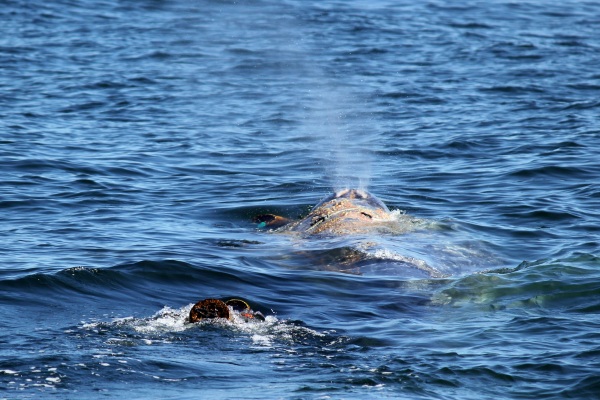
A note from The Truth Denied Team
PLEASE , we urge you to do whatever you can to stop the madness. To help us, please either contact Rosalind Peterson at the above listed phone number or Contact Roxy Lopez at info@thetruthdenied.com
Humans have the ability to destroy all living things on this planet. Humans also have the ability to change everything by simply taking action, not only to preserve the life we have on Planet Earth, but to improve the quality of life for ALL LIVING THINGS.
Please, TAKE ACTION TODAY. Call, email, write and share the message.

